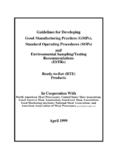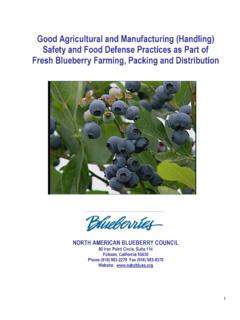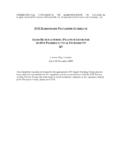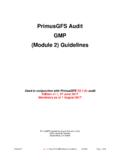Transcription of SUPPLEMENTARY GUIDELINES ON GOOD …
1 Working document May 2016 Draft document for comment Draft document for comment SUPPLEMENTARY GUIDELINES ON 1 good manufacturing practices FOR HEATING, 2 VENTILATION AND AIR-CONDITIONING SYSTEMS FOR 3 NON-STERILE PHARMACEUTICAL DOSAGE FORMS 4 (May 2016) 5 REVISED DRAFT FOR COMMENT 6 7 8 9 10 11 World Health Organization 2016 12 All rights reserved. 13 This draft is intended for a restricted audience only, the individuals and organizations having 14 received this draft. The draft may not be reviewed, abstracted, quoted, reproduced, transmitted, 15 distributed, translated or adapted, in part or in whole, in any form or by any means outside these 16 individuals and organizations (including the organizations' concerned staff and member 17 organizations) without the permission of the World Health Organization.
2 The draft should not be 18 displayed on any website. 19 Please send any request for permission to: 20 Dr Sabine Kopp, Group Lead, Medicines Quality Assurance, Technologies, Standards and Norms, 21 Department of Essential Medicines and Health Products, World Health Organization, CH-1211 22 Geneva 27, Switzerland. Fax: (41-22) 791 4730; email: 23 24 The designations employed and the presentation of the material in this draft do not imply the 25 expression of any opinion whatsoever on the part of the World Health Organization concerning the 26 legal status of any country, territory, city or area or of its authorities, or concerning the delimitation 27 of its frontiers or boundaries. Dotted lines on maps represent approximate border lines for which 28 there may not yet be full agreement. 29 The mention of specific companies or of certain manufacturers products does not imply that they 30 are endorsed or recommended by the World Health Organization in preference to others of a similar 31 nature that are not mentioned.
3 Errors and omissions excepted, the names of proprietary products are 32 distinguished by initial capital letters. 33 All reasonable precautions have been taken by the World Health Organization to verify the 34 information contained in this draft. However, the printed material is being distributed without 35 warranty of any kind, either expressed or implied. The responsibility for the interpretation and use 36 of the material lies with the reader. In no event shall the World Health Organization be liable for 37 damages arising from its use. 38 This draft does not necessarily represent the decisions or the stated policy of the World Health 39 Organization. 40 Should you have any comments on the attached text, please send these to Dr S. Kopp, Group Lead, Medicines Quality Assurance, Technologies, Standards and Norms with a copy to Ms Marie Gaspard by 12 July 2016. Medicines Quality Assurance working documents will be sent out electronically only and will also be placed on the Medicines website for comment under Current projects.
4 If you do not already receive our draft working documents please let us have your email address (to and we will add it to our electronic mailing list. Working document page 2 SCHEDULE FOR THE PROPOSED ADOPTION PROCESS OF 41 DOCUMENT 42 SUPPLEMENTARY GUIDELINES ON good manufacturing 43 practices FOR HEATING, VENTILATION AND AIR- 44 CONDITIONING SYSTEMS FOR NON-STERILE 45 PHARMACEUTICAL DOSAGE FORMS. 46 PROPOSAL FOR REVISION 47 Discussion of proposed need for revision in view of the current trends in engineering and experience gained during the implementation of this guidance in inspection during informal consultation on data management, bioequivalence, GMP and medicines inspection 29 June 1 July 2015 Preparation of draft proposal for revision by Mr D. Smith, consultant to the Medicines Quality Assurance group and Prequalification Team (PQT)-Inspections, based on the feedback received during the meeting and from PQT-Inspections July August 2015 Circulation of revised working document for public consultation September 2015 Consolidation of comments received and review of feedback 10 October 2015 Presentation to the fiftieth meeting of the WHO Expert Committee on Specifications for Pharmaceutical Preparations 12 16 October 2015 Consolidation of comments received and review of feedback January March 2016 Discussion at the informal consultation on good practices for health products manufacture and inspection, Geneva, 4 6 April 2016 Preparation of revision by Mr D.)
5 Smith, based on comments provided by Mr A. Kupferman and Dr Van Zyl, both participants at the above-mentioned consultation. May 2016 Circulation of revised working document for public consultation May 2016 Working document page 3 48 49 50 51 Consolidation of comments received and review of feedback August September 2016 Presentation to the fifty-first meeting of the WHO Expert Committee on Specifications for Pharmaceutical Preparations 17 21 October 2016 Any other follow-up action as required .. Working document page 4 BACKGROUND 52 During the consultation on data management, bioequivalence, GMP and 53 medicines inspection held in 2015 the possible revision of the guidance 54 for (WHO Technical Report Series, No. 961, Annex 5, 2011) was 55 discussed with the inspectors. It was suggested that in light of the new 56 developments a draft for revision be prepared. This new proposal for 57 revision was drafted based on the feedback received, the new, current 58 trends in engineering and the experience gained during the implementation 59 of this guidance in inspection.
6 60 At the same time, the opportunity was used to improve the graphic images 61 and make them more readable in e-version as well as in print. 62 Summary of main changes 63 Below is a list of the main changes that have been made to the WHO Technical 64 Report Series, No. 961, 2011, Annex 5: SUPPLEMENTARY GUIDELINES on good 65 manufacturing practices for heating, ventilation and air-conditioning systems for 66 non-sterile pharmaceutical dosage forms. 67 68 1. The Premises section has been moved towards the beginning of the document 69 due to its important impact on HVAC designs. In addition the text has been 70 expanded and a number of sample layouts have been included. 71 72 2. The HVAC sections have been re-arranged into a more logical sequence. 73 74 3. The Commissioning, Qualification and Validation (C, Q & V) section has 75 been aligned with the proposed revisions to the SUPPLEMENTARY GMP 76 Validation TRS, No.
7 937, Annex 4 GUIDELINES . 77 78 4. Significant notes were added under the new SUPPLEMENTARY notes on test 79 procedures section. 80 81 5. The Maintenance section has been separated out of the C, Q & V section. 82 83 6. All the diagrams have been revised (mainly to achieve better clarity). 84 85 7. Throughout the document additional notes have been added and text revised 86 to provide better understanding and avoid ambiguity. 87 88 89 Working document page 5 Contents 90 91 page 92 1. Introduction 93 2. Scope of document 94 3. Glossary 95 4. Premises 96 5. Design of HVAC systems and components 97 General 98 Air distribution 99 Recirculation system 100 Full fresh-air systems 101 Additional system components 102 6. Protection 103 Products and personnel 104 Air filtration and air patterns 105 Unidirectional airflow 106 Infiltration 107 Cross-contamination and contamination 108 Pressure differential concept (high pressure differential, 109 low airflow) 110 Physical barrier concept 111 Temperature and relative humidity 112 7.
8 Dust control 113 8. Protection of the environment 114 General 115 Dust in exhaust air 116 Vapour and fume removal 117 9. Commissioning, qualification and validation 118 General 119 Commissioning 120 Qualification 121 SUPPLEMENTARY notes on test procedures 122 General 123 Airflow measurements 124 Non-variable air particle counts 125 HEPA filter integrity tests 126 10. Maintenance 127 References 128 Further reading 129 130 Working document page 6 1. INTRODUCTION 131 132 Heating, ventilation and air-conditioning (HVAC) play an important role in 133 ensuring the manufacture of quality pharmaceutical products. A well designed 134 HVAC system will also provide comfortable conditions for operators. 135 136 These GUIDELINES mainly focus on recommendations for systems for 137 manufacturers of non-sterile dosage forms, and include tablets, capsules, 138 powders, liquids, creams, ointments, etc.
9 The HVAC design principles 139 contained in the GUIDELINES may be applied to other dosage forms. 140 141 HVAC system design influences architectural layouts with regard to items 142 such as airlock positions, doorways and lobbies. The architectural components 143 have an effect on room pressure, differential cascades and cross-144 contamination control. The prevention of contamination and cross-145 contamination is an essential design consideration of the HVAC system. In 146 view of these critical aspects, the design of the HVAC system should be 147 considered at the concept design stage of a pharmaceutical manufacturing 148 plant. 149 150 Temperature, relative humidity and ventilation should be appropriate and 151 should not adversely affect the quality of pharmaceutical products during 152 their manufacture and storage, or the accurate functioning of equipment. 153 154 This document aims to give guidance to pharmaceutical manufacturers 155 and inspectors of pharmaceutical manufacturing facilities on the design, 156 installation, qualification and maintenance of the HVAC systems.
10 157 These GUIDELINES are intended to complement those provided in good 158 manufacturing practices for pharmaceutical products (1) and should be read 159 in conjunction with the parent guide. The additional standards addressed by 160 this guide should, therefore, be considered SUPPLEMENTARY to the general 161 requirements set out in the main principles guide (WHO Technical Report 162 Series, No. 961, Annex 3) 163 164 2. SCOPE OF DOCUMENT 165 166 These GUIDELINES focus primarily on the design and good manufacturing 167 practices (GMP) requirements for HVAC systems for facilities for the 168 manufacture of solid dosage forms. Most of the system design principles 169 for facilities manufacturing solid dosage forms also apply to facilities 170 manufacturing other dosage forms (such as liquids, cream, ointments) and 171 other classes of products including biological products, herbal medicines, 172 complementary medicines and finishing process steps for APIs.
















